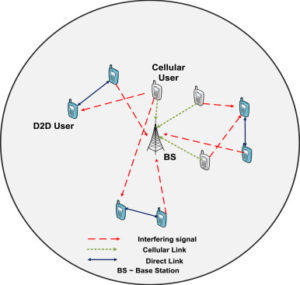Device-to-Device Networking Meets Cellular via Network Coding

Device to device Communication
The increasing popularity of diverse applications in today’s mobile devices introduces higher demand for throughput, and puts a strain on network resources especially on cellular links. In fact, cellular traffic is growing exponentially, and it is expected to remain so for the foreseeable future. The default operation in today’s networks is to connect each mobile device to the Internet via its cellular or Wi-Fi connection, On the other hand, utilizing device-to-device(D2D) connections simultaneously with the cellular connections is promising to meet the increasing throughput demand. In particular, when mobile devices are in the close proximity of each other and are interested in the same content, D2D connections such as Wi-Fi Direct can be opportunistically used to construct a cooperative (and jointly operating) cellular and D2D networking system.
We consider a scenario that a group of mobile devices are within one another’s transmission range and thus can hear each other. These cooperative mobile devices, are interested in the same content, e.g., video, exploit both cellular and D2D connections. In this setup, a common content is broadcast over cellular links. However, mobile devices may receive only a partial content due to packet losses over cellular links. The remaining missing content can then be recovered by utilizing both cellular and D2D connections simultaneously in a cooperative manner. Cellular links and D2D connections (namely Wi-Fi Direct) operate concurrently.Thus, a mobile device can receive two packets simultaneously, one via cellular, and the other via D2D connections. The fundamental question in this context, and the focus of this paper, is to design and analyze efficient network coding algorithms that take into account (i) concurrent operation of cellular and D2D connections, and (ii) the cooperative nature of mobile devices.
Get IEEE 2018 Project Topics List
